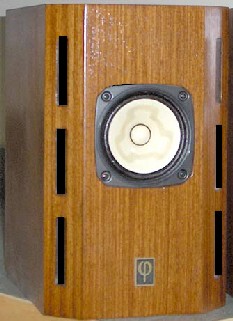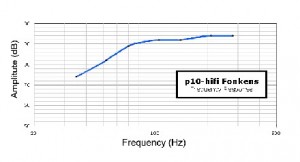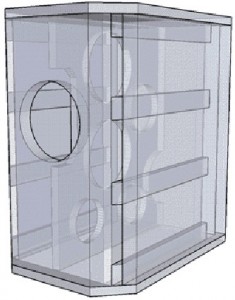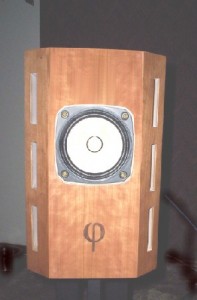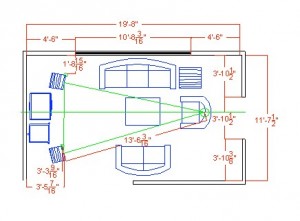Specifications:
- Full range, modified Fostex 127 driven Onken style enclosure, cherry veneer, with dark walnut “Phi” insignia Dimensions: 14″ X 8-5/8″ X 11-3/4″
- (356mm X 219mm X 208mm)
- Price as tested: $800.00 (CAD)
- Typical price : $700.00 (CAD)
How’s that for an intro? Now beam me up Scotty!
To begin with, and without repeating items that I have included in my interview with Dave Dlugos (aka Planet10), I will attempt to explain the “Onken” style enclosure. These enclosure types work well with many drivers, from the monstrous Altecs, JBLs, etc, to the diminutive little buggers installed in the particular set that I have had at home for review. For those of you that aren’t into reading interviews, I’ll provide this brief overview of Dave: Planet10 has been a resource for a few years on the Internet. Dave has been a moderator and a topposter on many sites and always brings his (well informed) take on things to discussions. He has developed a box library of some interesting designs (not all his) and has, in my opinion been near the forefront of DIY loudspeaker design and service to the audio community. And he gives credit where it is due, he’s the first to point out that he has two left thumbs and relies on his partner in crime (Chris) to actually do practical construction, and others (Scott Lindgren for example) for some technical help as well. Enough said about that. Now onto some info and the review.
Many may not have had the opportunity to see an Onken enclosure. In a time when consistent materials were not available, the Onken enclosure was devised. In fact, the original patent for a bass reflex enclosure, uses the Onken style of cabinet as an example (apparently the first occurrence of it mentioned anywhere). The walls can be quite thin in comparison to the enclosure, but if made using good quality (read no MDF here!) materials, is well braced internally. In the case of the Fonkens, Dave states that there is no span greater than 5-1/2″ or so that is not braced. A pretty amazing feat, considering the small size of the box and it’s internal volume. Speaking of boxes, Dave uses Baltic Birch plywood exclusively (well Chris actually). The enclosures are near aperiodic, which means that they have a restrictive port. The benefit of this type of enclosure is that the impedance of the loudspeaker is very well behaved when compared to typical bass-reflex ported designs and the drivers can be used in boxes typically to small for them. Examples of well known aperiodic designs are the Dynaco loudspeakers and the Dynaudio variovents types. It also allows for a smaller than usual enclosure for a given driver size (see the Dynaco A25 on planet10’s transmission line page: http://www.t-linespeakers.org/classics/dynaco.html.
Another great place to get an understanding of the resistive vent type of enclosure is: http://wduk.worldomain.net/acatalog/SpkrKits.html. A modern interpretation of the classic Dynaco A25 loudspeaker. As far as doing a comparison of the bass reflex, Onken, and other resistive loaded types, I’ll leave that to someone else who has more experience. I will say that I do love my old A25s, and have enjoyed good bass reflex types, and open baffles. Some personal experience with transmission lines is limited to the DCM Timeframes of approximately 20 years ago. I listened to them recently enough to know I still enjoy their sound, despite really cheap Phillips type drivers. My personal experience with planar speakers is not very current (I can’t remember the last time I heard them, maybe 15 or 16 years ago). Finally, electrostatics—not in the last 20 years.
I did try my hand at an absolute terrible frequency sweep (my method, not the actual sweep results). 35 Hz is approximately 20 dB down, 52:-12, 70:-5, 105:,-2, 140:-2, 280:0. So what does it look like? The curve (which I won’t make you suffer through my red-neck measurements and interpretation anymore), is smooth, with no real jumps. The-6dB level is approximately 65Hz which is not that far behind my fairly efficient, Castle Durham 900 loudspeakers that use a very nice 5-1/4″ mid-bass driver. Because I enjoyed everything so much, I stopped at 280 Hz. I was just curious as to the available bass in relative terms. But really, who cares? These measurements were done with the speakers approximately 44″ from the rear wall, in room. It should be noted that Planet10-hifi does modifications to the Fostex drivers, including basket dampening and cone treatments. The net effect is a reduction of some “raggedness” to the drivers response and resonant characteristics. Please have a look at Dave’s site for further information and comments (thanks Scott).
Fee M (Phi) fo fum…
The little Fonkens are finished very attractively. Not a “garage’ type finish job. These particular speakers have some minor fit and
finish problems, namely the CNC’d front baffle cut out to flush mount the drivers. Dave tells me that the enclosure follows the Golden Ratio, a wonderfully simple and complex ratio that occurs in nature and is one of mathematics most interesting “numbers”. For a great book about the Golden Ratio, have a look at Mario Luivio’s ,The Golden Ratio. And the ratio has to about our lives and nature than just loudspeaker enclosures (For example–and sorry about the male bias here…look at the photo of what many would say is a beautiful woman. The shape of her body isn’t important, but the ratios are. A “petite” woman is often disproportionate, kinda of a “cute” look, regardless of age. Stretch the body part that is disproportionate to a factor of M. Now take another look. Beauty is in the eye of the beholder, but most would agree the formerly petite woman is now much more attractive. Similarly, for the women in our readership, the same effect can be accomplished by doing exactly the same thing to a disproportionate male body, or a building or a flower…)
Despite the coding being correct on the CNC router, there is a small gap around parts of the black-framed Fostex drivers. Dave assures me that this has been worked on and that the rebates are now done in-house for quality assurance. Me, I’d painted the cutout black. Mount the drivers, and nobody notices. Also the vents (I think) would look better with a dark stain or painted a dark colour (Dave has suggested that the end user can make that call for themselves, it is easy to darken the vents if required than to go to lighter vents if so desired–a common sense approach). The nearwhite Baltic Birch contrasts with the cherry veneer in an odd way–we expect to see shadows in small spaces, but in this case we see light! To me it is a little odd to look at them . The rear contains a manufacture’s sticker, and a relatively inexpensive looking terminal cup. However, the binding posts did grip the spades on my speaker cables adequately, and bananas fit them snugly. Dave and others, please hear my plea…. try to oneup the competition regarding binding posts. A few more dollars spent on the binding posts can be justified in a higher price. And I’m not talking about uber expensive types. ( Dave stated that he and Chris have compared these cups/binding posts to others that are more expensive and found these to work the best. Presently, Fonkens are supplied with removable wooded panels and binding posts). Dave is(rightly) quick to point out that because all Fonkens are custom built, any type of binding post can be used (and charged for accordingly).
And now, some listening notes about Fonken speakers:
First, the cons: These speakers pretty much suck! (at dumbass volume levels with hard hitting glam rock or anything that might be considered “heavy”) Even at low levels they left you wanting more. For this type of listener (count my wife as one of them), a pair of powered subs with big solid-state amplification should fit the bill. Dave has plans and supplies available to help you out there.
That’s pretty much the end of the bad news. There is one minor nag, and that is amplifier suitability. Low dampening factor amps, (typically small single ended triode types, but also including the T-amps and other digital amps) are a requirement. Hooked up to the 125 watt/ch McCormack DNA 0.5 deLuxe was an absolute waste. Anyone who would actually intentionally purchase these speakers for this kind of power amp completely misses the point! I had to try it, knowing full well the results. So, any prospective buyers need to understand that a high dampening factor amp is simply a bad choice with these and other small full range loudspeakers
For pretty much any smaller sounding stuff, these things kick. No, you will not create a breeze in your listening room , you simply cannot fight the physics. But they don’t leave you feeling lacking. I reserve the right to add further comments as I try out some larger scale orchestral works later on.
Earlier I was listening to some Allman Brothers stuff. Most notably the Martin Scorsese Presents the Blues series cd, and a few cuts from one of my favourite movie soundtracks , “Rush”. (Eric Clapton and the Allman Brothers Band). I dug it. There was no wanting for more at all. Yes there is no real deep bass, but the balance of the speaker is very good. If more upper end extension is needed, I can’t hear it. (I’m 42 and have what I consider decent hearing–not too many rock concerts or car audio experiences. When younger , we actually heard engines and tires, not stereos!).The same can be said of Melvin Taylor and his Slack Band ‘s Dirty Pool (mainly SRV covers, but a few others , played by a great guitarist and singer). Kenny Wayne Shepard’s Trouble Is album has a few startling songs and a couple of nice covers, including “Blue on Black”, in particular.
Mary Black (Best of Mary Black) sounded as good as I’ve heard. Lots of acoustical space retrieval. “Babes in the Woods” had an eerie quality–a little “apherreal”. “Only a Woman’s Heart”, a duet with Eleanor McElvie, was presented with the voices being projected well beyond the confines of the speakers. Have I mentioned how “unbox-like” the Fonkens are? If I haven’t this cannot be understated. On “A Song for Ireland”, there was a little bit of edginess during her crescendo, but it was not too annoying (but right on the verge). This is perhaps one of the toughest tests for a speaker to accomplish (well any gear, it can be heard on cd players, amplifiers, etc. I just about have it completely tamed in my system)
Loreena McKinnet’s “Marco Polo” from her Book of Secrets disc, is my test of musical emotion. The Fonkens passed with flying colours. K.D. Lang’s live “Halleluiah” fromWomen in Song 9 was believable. There was a slight nasal sound to her voice, but is it closer to reality than I’ve heard? Probably, I’ve never heard her live (Scott Lungren did indicate that he has heard K.D. live and that she does have a slight nasal quality to her voice..slight). Same with Sarah McLauglin’s “Song for a Winter’s Night” (Wintersong). Voices were beautifully rendered and easy to hear as separate voices. Guitar was beautiful with realistically reproduced finger work on the fret board. I could go on and on about every piece of music that I listened to, but I won’t. I now can say, after digging it out that Arthur Fiedler and the Boston Pops Orchestra (Out of this World) was excellent, sounding much bigger than the width and depth of my room could possibly be.
So, a thumbnail listening “sketch” of the Fonkens:
Tone: I’d say accurate without being overly “taunt” (or over dampened) sounding. Bass extension: surprising considering the size of the Fonkens, and the 4″ drivers. Perhaps a testament to the Planet10 modifications. It has also been pointed out to me that the Fonkens would have had considerably more bass extension had I placed them closer to the rear wall. Unfortunately this is not possible without “closing them in” and I think giving up some of their special qualities in my room. Treble extension is good, or maybe better than my hearing (maybe I’ve started going deaf?). My nephew the drummer, liked the sound of drums and cymbals through the Fonkens, and he’s very sensitive to these sounds (and thankfully has protected his hearing for the 15 or so years as a drummer). But for music I don’t find them lacking. Midrange, including both male and female vocal is outstanding. Soundstaging (height, width and depth) are good to excellent. On some recordings a littleclosed in, is it the poor placement demanded in my room or the accuracy of the speakers that was showing off?
The question is, could I live with the Planet10hifi Fonkens long-term as a single set of loudspeakers in the context of the review presented here? Yes! I had them in house for more than a calendar month and enjoyed every experience listening to music, and they made me want to listen to as much as I could. Any caveats? Only the need for suitable, low dampening factor amps as already stated, and suitably high quality sources and pre-amp. Scott Lungren made the point that if a suitable resistor is placed in series with the positive speaker cable, a reduced dampening effect will occur, increasing their suitability greatly with a wider range of amplifiers. “A 34 ohm of series resistance added, either by a resistor, or preferably with a resistive speakercable” is what Scott had suggested. I didn’t try it as I has already packed the speakers up before learning about this. Given these conditions, I think they represent a sonic value. The aesthetics alone are worth the price of admission. The tactile feel is unbelievable as you unpack them. To see them in the flesh is to want to touch them, and to touch them is to want to hold them, and to listen to them is to want to keep them. I think they are special in a most enjoyable way. And put them on good speaker stands, they deserve it.
News flash!
Here’s a great piece of news for those that are handy: Planet10-hifi will sell you the modified drivers for just $ 140 (CDN) a pair and give you the plans (Plans are freely available for download from the planet10-hifi Box Library for non-commercial use only). And for those that are less so: Dave says that they (him n’ Chris) are currently developing a knock-down flat-pack kit of fully machined enclosure parts and components All you need do is supply and apply the veneer when done Targeted price is a paltry $340 (me, I like the look of Baltic Birch, even the ply edges— I’ll take mine in natural finish and a few coats of clear urethane). Stay tuned. If these speakers are representative of the work that Dave, Scott and Chris are capable of, I look forward to listening to others that they develop and offer up for sale, in limited quantities.
Equipment used for this review:
- JE Labs open baffles/ Oxford 12J4s musical instrument wide rangers w/Vifa tweeters and 2-way crossovers
- 41Hz Amp6Basic digital “T” amp / McCormack Micro-line Drive pre-amp combo a short length (.5 metre) of Audioquest “Quartz”interconnects
- PS Audio lll phono stage/Oracle Alex Mkll turntable/SME 309 tone arm (newest series, with magnesium arm tube) /Grado Signature
- 8 cartridge. Stock Van den Hul D-102 hybrid interconnects,
- Pioneer “Elite” PD54 cd player (stable platter)
- Castle Durham 900 loudspeakers
- Audioquest Ruby Interconnects/Type 4 speaker cable/ Indigo speaker cable/ XLO “green” AC cable/ Tiff”purple” AC cable
- Target Delta 5 welded equipment rack and Target medium mass 24″ speaker stands
A Note: it was pointed out to me that I did not include the speaker location in the review. I listened with the Fonkens 44″ or so from the rear wall and with 2″ of toe in. Please see the sketch of my living room.
external link: Planet10-Hifi Fonkens
 from affordableaudio, By Stew Nelless
from affordableaudio, By Stew Nelless
